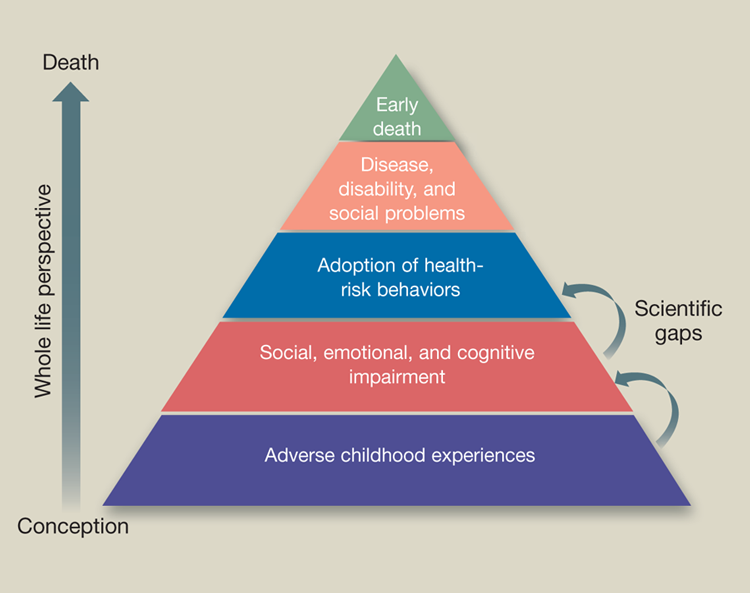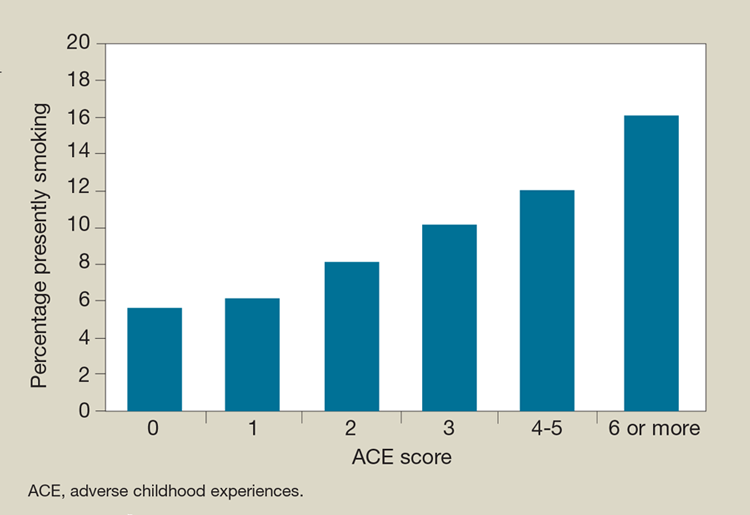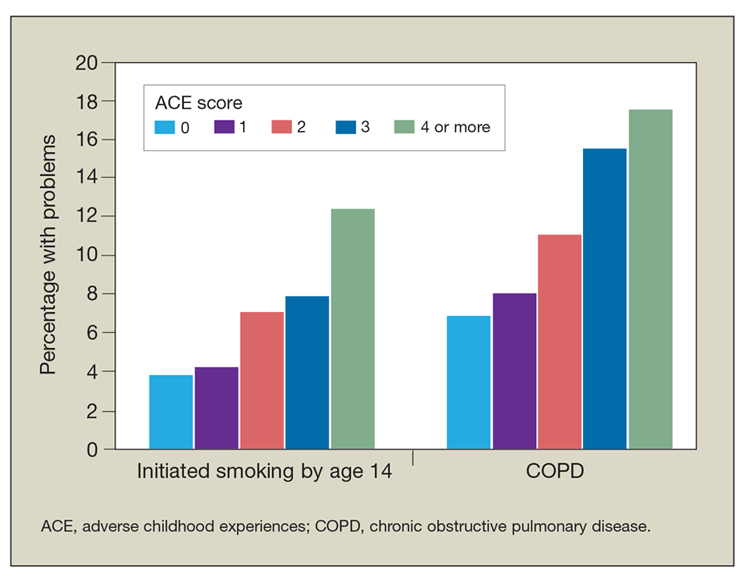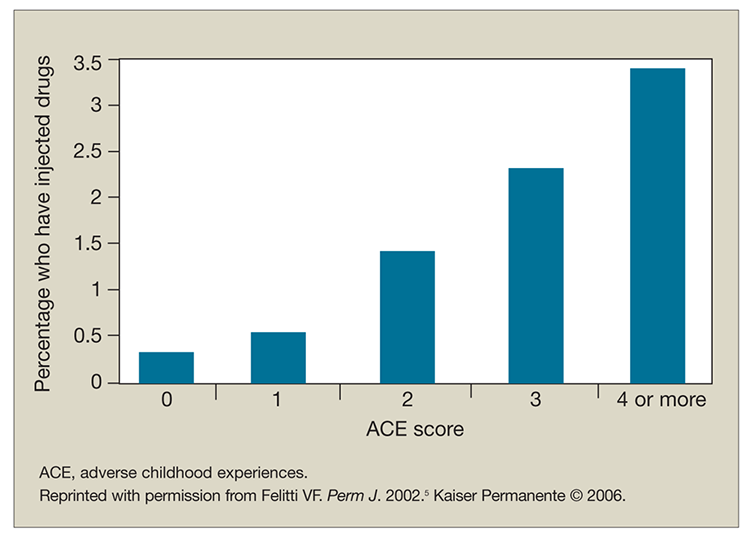Adult Implications of Childhood Maltreatment
Maltreatment at an early age casts a very long shadow. Here: a look at the long-term effects of early childhood trauma.
Figure 1. Adverse childhood experiences pyramid.

Figure 2. As the ACE score goes up, the number of those who answered the survey that they are current smokers goes up.

Figure 3. As the ACE score goes up, the number of those who reported smoking by age 14 and the number who reported a diagnosis of COPD go up.

Figure 4. As the ACE score goes up, self-reported intravenous drug use goes up.

Every year the US Department of Health and Human Services publishes data on childhood maltreatment. In 2012, there were 3.4 million referrals to child protective services.1 Of those, 686,000 unique victims were identified, with an estimated 1640 deaths. Overall mortality in children aged 1 to 4 years and in children aged 5 to 14 years was 26.5 and 12.9 per 100,000, respectively.2
The majority (70.3%) of fatalities were in children younger than 3; children in their first year of life had the highest rates of victimization-at 21.9 per 1000.1 Boys had a higher fatality rate than girls: 2.54 compared with 1.94 per 100,000. There were more fatalities in white children (38.3%) than in African Americans (31.9%) and Hispanics (15.3%). The vast majority (80%) of maltreatment and child fatalities were perpetrated by one or both parents. The most common types of maltreatment were neglect (78.3%), physical abuse (18.3%), and sexual abuse (9.3%).
From 2008 to 2012, childhood maltreatment prevalence declined by 3.3%.1 In addition, the rate of recurrence also declined slightly over this period. The reasons for improvement are unclear and may be multifactorial. Prior trends in improvement were explained by a host of factors, including economic issues, availability of psychopharmacological agents, and increased awareness of maltreatment.3
Adult implications
As distressing as the data are, maltreatment is only the beginning of the story-maltreatment at an early age casts a very long shadow. One of the critical studies in evaluating the longitudinal impact of childhood maltreatment is the Adverse Childhood Experiences (ACE) Study.4 The study was designed to understand the long-term effects of early childhood trauma-whether such trauma is one of the first dominoes in a long line that eventually leads to poor health outcomes in adulthood (Figure 1). The researchers looked at how childhood traumatic experiences affect social and emotional well-being as well as what factors lead to the adoption of health-risk behaviors.
The ACE Study was conducted from 1995 through 1997 at Kaiser Permanente’s San Diego health appraisal clinic, where more than 45,000 standardized annual well-care examinations were done every year. Over the study period, questionnaires were sent out, and more than 17,000 patients responded.4,5 On average, the respondents were in their mid 50s, 75% were white, 93% were high school graduates, and almost 40% were college graduates. The participants were queried about their current and past health in addition to aspects of their social his-tory. The traumatic events the survey delved into included verbal abuse, physical abuse, sexual abuse, intimate partner violence, household substance abuse, mental illness, incarcerated household member, and parental separation or divorce. A point was given for exposure to any of these adverse childhood experiences. Because the respondents were getting standardized annual well-care examinations, the researchers used the data from these visits as part of the analysis.
Close to two-thirds of the respondents had a score of 1 or more; 25% had a score of 2 and approximately 6% had a score of 4. After a positive response in one category, there was an 80% chance of having a second positive response, and a 70% chance of having a third positive response. In addition to evaluating the mere exposure to these adverse experiences in childhood, the surveys also asked how often/severe/invasive the abuse was. When evaluating this study, it is important to remember that the goal of the survey was to understand the impact of childhood experiences decades later.
The researchers also looked at the effects that the adverse childhood experiences had on adult health. Verbal abuse or physical abuse and injury increased the risk of having a BMI greater than 40 by 88% and 71%, respectively.6 In addition, findings indicate that 8% of patients had a BMI greater than 30 and 17% had a BMI greater than 40 that was attributed to childhood maltreatment. Other studies have confirmed these findings. For example, when children with court-substantiated abuse or neglect were matched with controls without this history, it was found that the prior maltreatment predicted higher BMI scores in adulthood (mean age of follow-up was 41).7
The ACE Study also looked at the effect of childhood maltreatment on smoking. It is important to understand that while in the past 30 years or so there has been a decline in smoking rates, there has been a slowing/plateau in the number of smokers.8 We wonder why some patients have such a hard time quit-ting smoking. Are they using nicotine to self-medicate? Data seem to support this. For instance, in those with an ACE score of higher than 5, the odds ratio (OR) for early start of smoking was 5.4; ever smoking, 3.1; history of heavy smoking, 2.8; and a doubled risk of being a current smoker at the time of the survey, 2.1.9
The ACE Study also showed a statistically significant response when it came to adverse events with various outcomes. The higher the score, the more likely that the respondent was a current smoker who had started smoking by age 14. Even more important, results of the study showed the same “dose response” with the diagnosis of chronic obstructive pulmonary disease (COPD). As the ACE score went up, the more likely it was that the respondent had a diagnosis of COPD at the time of the survey.5,9,10Figures 2 and 3 show this dose-response relationship between childhood maltreatment and risks of smoking and smoking-related disease.
My own experience relating to the smoking data occurred in 2003. I had previously attended a child abuse conference in San Diego where the ACE Study data were highlighted. I decided to use that information in my primary care office. I had a patient in her mid 60s with COPD who continued to smoke despite numerous efforts to quit. She had come in to follow up on her COPD and to discuss smoking cessation. As the conversation steered toward her prior failed attempts, I reviewed the findings that indicated that sometimes people who have a hard time quitting may have had something bad happen in childhood, and so I asked her, “did anything really bad happen to you?” She looked at me and then broke down in tears. The story came out that she was repeatedly raped by friends of her father’s when she was an early teen. I was the first person she had told in 50 years.
Suicide attempts were another area of interest for the researchers in the ACE Study. The data again showed a statistically significant response between the ACE score and the risk of attempted suicide. The relationship persists even after concurrent alcoholism, depression, and illicit drug use are accounted for. The OR of attempting suicide for any one of the positive adverse childhood experiences is 2 to 5; emo-tional abuse was associated with the highest increased risk.11 Moreover, there is a strong graded and statistically significant relationship between the ACE score and risk of suicide. As the ACE score went up, the risk of attempted suicide increased from an OR of 1.7 with an ACE score of 1, to an OR of 17 (ie, 17-fold greater risk) with an ACE score greater than 7.11
Just as with the obesity data, the attributable risk factor for attempted suicide was calculated with results that were quite astonishing. The researchers found that 80% of childhood and adolescent suicide attempts and 67% of lifetime suicide attempts could be attributed to an adverse childhood experience. Unfortunately, these data are probably an underestimate of the impact because the survey relied on patients who recalled events from childhood decades later and did not include people who had completed suicide.
Other areas examined with the ACE data included sexually transmitted diseases, alcohol abuse, and intravenous drug abuse. Figure 4 shows the relationship between the ACE score and intravenous drug abuse. All demonstrated the same outcome of a statistically signifi-cant response. The higher the ACE score, the more likely that the adult had a positive response to the outcome.2,12,13
Type 2 diabetes mellitus has also been evaluated. Although the ACE Study did not show a link between childhood maltreatment and an increased risk of diabetes, another study did. Using data from the Nurses Health Study, researchers found that more severe childhood abuse had a dose-response relationship with diabetes. The increased risk was only partially explained by obesity because when data were adjusted for obesity, results still showed an increased risk of 10% to 30%.14
One thing to remember is that the types of abuse in the ACE Study and many other similar studies did not include neglect, which accounts for more than 75% of childhood maltreatment.
The connection between ACE and negative health outcomes
A review of the data seems to show that the worse a patient’s childhood, the higher the risk of adverse events as an adult. But what is the reason for these outcomes? Certainly they could be explained as coping mechanisms for dealing with the abuse, such as overeating, smoking, and sex at an early age. Studies in this arena focus on how chronic stress can lead to dysfunction in biological and neurological systems.15-17 In addition, there may be a genetic component that increases susceptibility.18
Biologically, our bodies often respond to stress with the secretion of chemicals such as glucocorticoids and adrenocorticotropic (ACTH) hormone.19 Cortisol and ACTH levels as well as parameters such as heart rate were found to be abnormally high before, during, and after performance of stress tests in individuals who had been maltreated in childhood.15-17 This suggests that those exposed to maltreatment are in a chronically stressed state biologically. Neurologically, anatomic studies using functional MRI, which evaluates brain function by tracking changes in the blood flow, show that in persons exposed to early stressors such as maltreatment, activity in the amygdala is different from that in controls.15
Genetically some individuals may be more prone to maladaptive responses to chronic stress; this shows evidence of genetic-environmental interactions. An example of this is looking at a gene for serotonin transport and risk of depression: one particular transporter has 2 forms, a short allele and a long. Studies on this serotonin transporter gene showed an environmental influence-only homozygotes for the short allele had an increased risk of depression when there had been a history of maltreatment.18
Another example is the effect of early stress on cell health. A study on older adults caring for a spouse or parent with dementia showed that the adults with a history of childhood maltreatment had higher levels of interleukin-6 and shorter telomeres than cohorts without childhood trauma.20
Family dynamics may also play a role. The ACE score for an individual can predict early family member death (defined as death before age 65), with the same response seen for other outcomes.21 It is likely that adverse childhood experiences cross generations (ie, patients with high ACE scores likely had parents with high ACE scores). Families can provide a form of social control that helps define and sanction healthy or unhealthy behaviors.
What can be done?
First and foremost, physicians need to understand the data and the implications on adult health. While child maltreatment is often seen as a pediatric issue, clinicians need to keep in mind that childhood maltreatment can cast a long shadow. Unfortunately, the evidence is not as robust on the treatment of adults with consequences of childhood trauma. That being said, once patients are identified, a plan can be discussed to address it. Group or individual psychotherapy has been shown to help female survivors of childhood sexual abuse and PTSD related to childhood or adult sexual abuse.22-24 In addition, the use of SSRIs and other pharmacotherapy can be considered.25
Advocacy to prevent childhood maltreatment, preventing teen pregnancy, improved support for dysfunctional households, and improved protection for children are possible and may have an impact, but further studies are needed. Finally, most important is education of medical students, residents, and other clinicians about the link between childhood maltreatment and adult health.
Disclosures:
Dr Hinch is Assistant Professor in the department of internal medicine and pediatrics and Associate Program Director IM Residency at the University of Toledo Medical Center in Toledo. He reports no conflicts of interest concerning the subject matter of this article.
References:
1. US Department of Health and Human Services. Child Maltreatment 2012. Washington, DC: US Government Printing Office; 2013.
2. Murphy SL, Xu J, Kochanek KD. Deaths: final data for 2010. Natl Vital Stat Rep. May 8, 2013. http://www.cdc.gov/nchs/data/nvsr/nvsr61/nvsr61_04.pdf. Accessed July 3, 2014.
3. Finkelhor D, Jones L. Why have child maltreatment and child victimization declined? J Soc Issues. 2006;62:685-716.
4. Felitti VJ, Anda RF, Nordenberg D, et al. Relationship of childhood abuse and household dysfunction to many of the leading causes of death in adults. The Adverse Childhood Experiences (ACE) Study. Am J Prev Med. 1998;14:245-258.
5. Felitti VJ. The relation between adverse childhood experiences and adult health: turning gold into lead. Perm J. 2002;6:44-47.
6. Williamson DF, Thompson TJ, Anda RF, et al. Body weight and obesity in adults and self-reported abuse in childhood. Int J Obes Relat Metab Disord. 2002;26:1075-1082.
7. Bentley T, Widom CS. A 30-year follow-up of the effects of child abuse and neglect on obesity in adulthood. Obesity (Silver Spring). 2009;17:1900-1905.
8. Centers for Disease Control and Prevention. Tobacco use. Targeting the nation’s leading killer: a glance at 2011. http://www.cdc.gov/chronicdisease/resources/publications/aag/osh.htm. Accessed July 3, 2014.
9. Anda RF, Croft JB, Felitti VJ, et al. Adverse childhood experiences and smoking during adolescence and adulthood. JAMA. 1999;282:1652-1658.
10. Edwards VJ, Anda RF, Gu D, et al. Adverse childhood experiences and smoking persistence in adults with smoking-related symptoms and illness. Perm J. 2007;11:5-13.
11. Dube SR, Anda RF, Felitti VJ, et al. Childhood abuse, household dysfunction, and the risk of attempted suicide throughout the life span: findings from the Adverse Childhood Experiences Study. JAMA. 2001;286:3089-3096.
12. Dube SR, Anda RF, Felitti VJ, et al. Adverse childhood experiences and personal alcohol abuse as an adult. Addict Behav. 2002;27:713-725.
13. Hillis SD, Anda RF, Felitti VJ, et al. Adverse childhood experiences and sexually transmitted diseases in men and women: a retrospective study. Pediatrics. 2000;106:E11.
14. Rich-Edwards JW, Spiegelman D, Lividoti-Hibert EN, et al. Abuse in childhood and adolescence as a predictor of type 2 diabetes in adult women. Am J Prev Med. 2010;39:529-536.
15. Taylor SE. Mechanisms linking early life stress to adult health outcomes. Proc Natl Acad Sci U S A. 2010;107:8507-8512.
16. Heim C, Newport DJ, Heit S, et al. Pituitary-adrenal and autonomic responses to stress in women after sexual and physical abuse in childhood. JAMA. 2000;284:592-597.
17. Bremmer JD, Vythilingam M, Vermetten E, et al. Cortisol response to a cognitive stress challenge in posttraumatic stress disorder (PTSD) related to childhood abuse. Psychoneuroendocrinology. 2003;28:733-750.
18. Taylor SE, Way BM, Welch WT, et al. Early family environment, current adversity, the serotonin transporter promoter polymorphism, and depressive symptomatology. Biol Psychiatry. 2006;60:671-676.
19. O’Connor TM, O’Halloran DJ, Shanahan F. The stress response and the hypothalamic-pituitary-adrenal axis: from molecule to melancholia. QJM. 2000;93:323-333.
20. Kiecolt-Glaser JK, Gouin JP, Weng NP, et al. Childhood adversity heightens the impact of later-life caregiving stress on telomere length and inflammation. Psychosom Med. 2011;73:16-22.
21. Anda RF, Dong M, Brown DW, et al. The relationship of adverse childhood experiences to a history of premature death of family members. BMC Public Health. 2009;9:106.
22. Price JL, Hilsenroth MJ, Petretic-Jackson PA, Bonge D. A review of individual psychotherapy outcomes for adult survivors of childhood sexual abuse. Clin Psychol Rev. 2001;21:1095-1121.
23. Westbury E, Tutty LM. The efficacy of group treatment for survivors of childhood abuse. Child Abuse Negl. 1999;23:31-44.
24. Foa EB, Dancu CV, Hembree EA, et al. A comparison of exposure therapy, stress inoculation training, and their combination for reducing posttraumatic stress disorder in female assault victims. J Consult Clin Psychol. 1999;67:194-200.
25. Ballenger JC, Davidson JR, Lecrubier Y, et al. Consensus statement on posttraumatic stress disorder from the International Consensus on Depression and Anxiety. J Clin Psychiatry. 2000;61(suppl 5):60-66.
26. Centers for Disease Control and Prevention. The ACE Pyramid. 2014. http://www.cdc.gov/violenceprevention/acestudy/pyramid.html. Accessed July 3, 2014.
